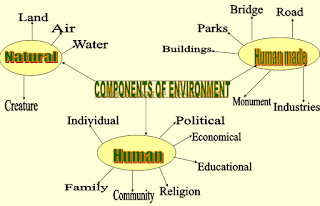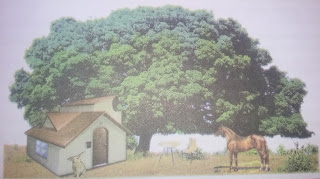Lesson Plan of Environment and its Components General Science Grade IV
Lesson Plan of Environment and its Components
General Science Grade IV
Students’ Learning Outcomes
·
Define environment.
·
Explain components of
environment with examples.
Information for Teachers
·
Environment can be defined as the natural
surrounding s of that organism which directly and indirectly influences the
growth and development of the organism.
·
Everything around an organism
that affects its life is called its environment.
·
Environment consists of two
components: living components and non-living components.
·
Living components of the
environment are animals, plants and microorganisms.
·
Non-living components of the
environment are air, water, soil, light etc.
Material / Resources
Blank paper, textbook
Worm up Activity
·
Ask students to tell the
names of things present in class, write the responding answer on board and
discuss that all these things make our environment.
Development
Activity 1
·
Take students to the school
lawn and ask them to identify different objects in the surroundings of a tree.
·
Let students categorize the
identified objects into living and non-living things.
·
Describe tree environment and
explain two components of its environment.
Activity 2
·
Show this picture / similar
one given to the students.
·
Ask them to observe and tell
the names of living and non-living things present in picture.
·
Write students’ response on
board, in separate columns of “living components” and “non-living components”
Activity 3
·
Mark the school garden/lawn
or playground into different sections. (try to include a variety of objects
such as plants, different types of insects, a fence, cement, rocks, soil, water
etc. in these sections)
·
Divide the students into
groups of 4 or 5 and ask each group to draw two large circle on a paper and label them as “living” and “non-living”.
·
Assign a separate section of
the garden/lawn/playground to each group and ask them to make lists of all
living and non-living components.
·
The group would enter the
names of living and non-living things in the respective circles. (Allow sufficient
time for students to explore their sections and complete the assignment).
Sum up / Conclusion
·
All living and non-living things
that surround an organism and can affect its life are collectively called its environment.
·
Every environment consists of
living and non-living components.
·
Living components of
environment include animals, plants and microorganisms.
·
Non-living components of
environment include air, water, soil, light etc.
Assessment
Students will demonstrate
their understandings by:
·
Describing the concept of
environment.
·
Distinguishing the living and
non-living components of environment.
Follow up
·
Ask students to observe their
home and school environment, write the names and draw / paste pictures of the
living and non-living things present in that environment.
Home
Environment
|
School Environment
|
||
Living things
|
Non-living things
|
Living things
|
Non-living things
|






Comments
Post a Comment